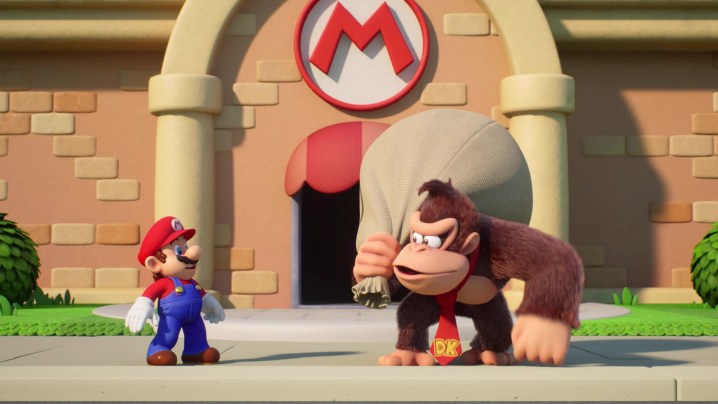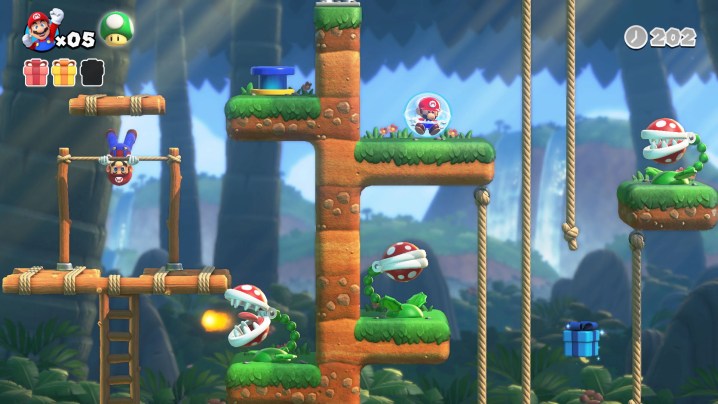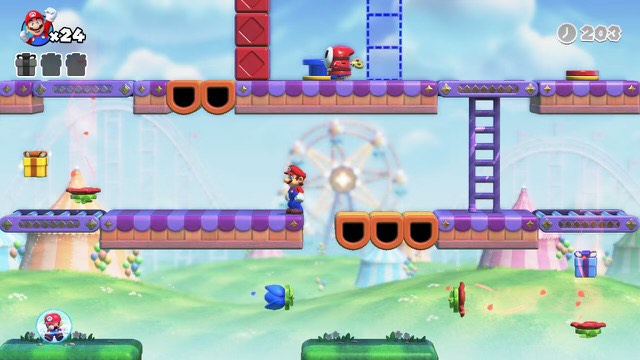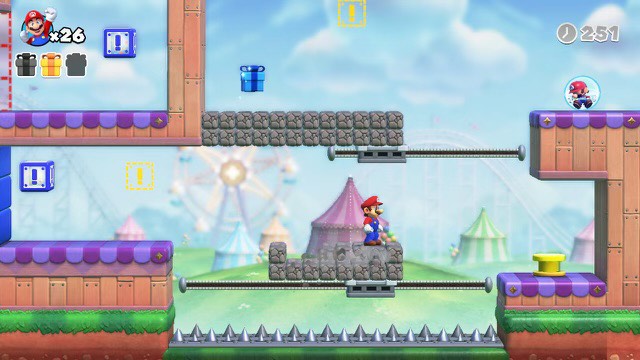
When it comes to Mario, Nintendo has remake fever. The publisher is currently on a hot streak as it revisits some of the series’ cult classics. We got a strong remake of Super Mario RPG last November and a new version of Paper Mario: The Thousand-Year Door is on the way this year. In-between those beloved titles, we’re getting a full remake of Mario vs. Donkey Kong, a unique Game Boy Advance puzzle-platformer. It’s something of a 20th-anniversary edition considering the original launched in 2004.
Ahead of its launch, I played through the remake’s first four worlds. For the most part, they’re 1:1 recreations of the original’s levels, with a charming visual boost that’s not far off from what we saw in Super Mario RPG. What I wouldn’t realize at first, though, is that one of those worlds was an entirely new addition made for the remake. That’s how naturally its new content slots in to a very faithful recreation.
Tiny changes
Like Super Mario RPG, Mario vs. Donkey Kong‘s Switch remake isn’t trying to mess with fans’ nostalgia. The core gameplay loop is entirely unchanged here: Mario moves through bite-sized 2D platforming levels turned into small puzzles. Each level has me finding a key and bringing it to a door, before sending me to a second screen where I need to rescue a mini Mario toy. I watched a YouTube video of the original game’s World 1 after beating the remake’s and it was almost identical.
There are some very subtle changes, though. For one, the remake removes high-score levels. There’s no longer a point bar at the top of the screen and the end result page only awards players a star if they collect three optional gifts in each stage. I’m assuming the unlockable Time Attack mode, which I have yet to test, brings that concept back, but I admittedly miss it in the base game. There’s not as much urgency to complete levels quickly aside from a stray stage gimmick like rising lava. Some tension gets lost in that change, though a ticking clock makes sure I’m at least a bit more conscious of how long I’m spending on each level.

Other changes are miniscule. Levels don’t start with a short introduction screen showcasing its special gameplay hook, and the original’s 1-Up minigame has changed. Players no longer pick a prize from boxes after a level. Instead, that’s replaced with a bonus stage that pops up in each world where players have 30 seconds to grab a flying key and unlock a cache containing five extra lives. I can’t imagine either change will ruffle any feathers (the only thing that might is that Mario isn’t quite as talkative in a newly reimagined opening cutscene).
For the most part, it seems like Nintendo wants to keep the remake as leisurely and approachable as possible. There’s not a brain-busting puzzle present in the first four worlds, which I 100% cleared without putting in too much thought. Nintendo doubles down on that with a casual mode, which adds more stage checkpoints and lets Mario survive a hit from an enemy. I imagine the goal is to make something even more kid-friendly here, reinforced by a co-op mode that seems built for parents who want to help their children through stages.
A whole new world
The original Game Boy Advance release was a very short game; even a 100% run only took around 10 hours. Perhaps realizing that such a length would be a tough sell for a $50 game, Nintendo has added in two entirely new worlds (both of which will have their own set of “+” stages after clearing the story). I’d get to try one of those in World 4: Merry Mini-Land.
Coming after the lava-filled Fire Mountain, Merry Mini-Land tosses Mario into a theme park-inspired world with some fresh gimmicks. Chief among those are flowers that double as air vents. When I step on one, both I and anything I’m carrying get blown along its path. This, unsurprisingly, creates some of the first half’s freshest puzzles. They have me thinking a bit more critically as I drop a key or a spring onto a vent and flip a switch at the right time to activate another flower, or turn blocks invisible, to continue the object’s path.

My favorite new stages compound a few ideas together. One standout has me using teleporting boxes to access different parts of the screens and hit switches in the correct order to grab a key. The second half is a more complex platforming gauntlet where I both have to time when I teleport to land on a moving platform and carefully hop over a row of falling rocks, making sure I can return to the other side safely after hitting a switch. Levels like that feel like a totally natural fit within the original worlds, keeping the same design spirit intact while flexing some modern creativity.
It’s great to see such high-quality additions included in the Switch version, though it does leave me with one lingering question: Was a remake really the best course of action for the series? It’s very apparent that the game underneath the new graphics was a 20-year old stab at starting a new puzzle series. Rigid movement combined with often obvious solutions makes the early worlds feel a little elementary. Considering that Mario vs. Donkey Kong doesn’t have a beloved story like Super Mario RPG, I’m not entirely sure what Nintendo gains here from remaking a niche GBA puzzler instead of creating an entirely new installment with a fresh set of puzzles.

It’s something I’m hoping the entire package answers as it’ll need to work to justify a $50 double-dip instead of dropping the original on Switch Online for subscribers. Though maybe that’s me overthinking it; there’s a nostalgic joy in seeing an underappreciated game return with a fresh coat of paint and a fantastic new soundtrack. Perhaps that’s all the average fan really wants.
Mario vs. Donkey Kong launches on February 16 for Nintendo Switch.
Editors’ Recommendations

